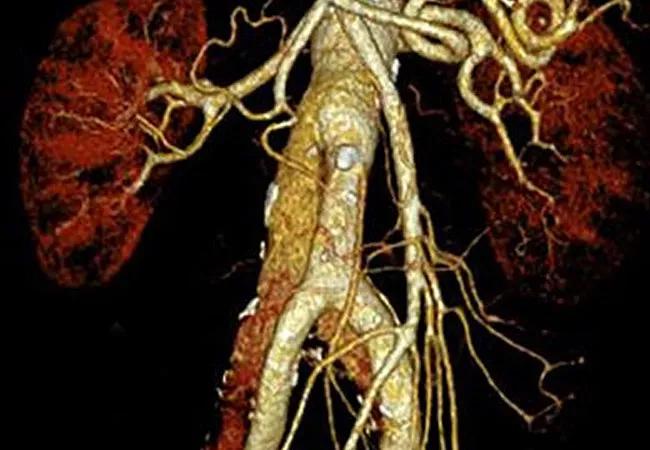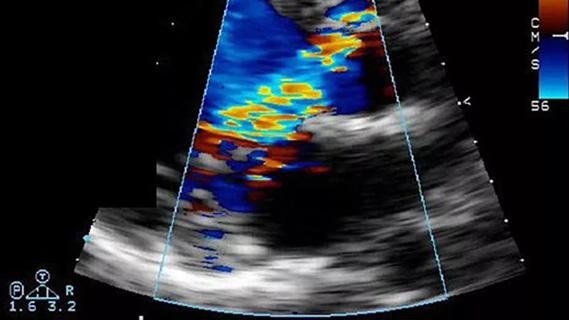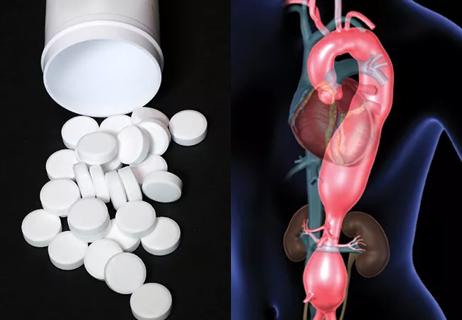Blood test can identify patients who need more frequent monitoring or earlier surgery to prevent dissection or rupture

A blood test widely available across the U.S. can predict how fast an abdominal aortic aneurysm is growing and identify those that one day will need surgical intervention to prevent dissection or rupture. This finding, recently published in JAMA Cardiology, is the latest in a long line of research linking cardiometabolic diseases with the blood biomarker TMAO (trimethylamine N-oxide).
Advertisement
Cleveland Clinic is a non-profit academic medical center. Advertising on our site helps support our mission. We do not endorse non-Cleveland Clinic products or services. Policy
TMAO is a metabolite of red meat and other animal products, produced by bacteria in the gastrointestinal tract. A Cleveland Clinic team led by cardiology researcher Stanley Hazen, MD, PhD, first reported TMAO’s association with cardiovascular disease in 2011. Subsequent research — now hundreds of studies — reported links between the metabolite and atherosclerosis, thrombosis and chronic kidney disease. A 2023 study published in Circulation showed that TMAO induces aneurysm formation in humans and serves as a therapeutic target in multiple animal models of aortic aneurysms.
“Our new study has gone one step further, showing how TMAO is the first blood biomarker in clinical use that can show which patients have fast-growing aneurysms that need more attention,” says Scott Cameron, MD, PhD, Section Head of Vascular Medicine at Cleveland Clinic. Dr. Cameron was a lead author of the paper along with Xinmin Li, PhD, of Cleveland Clinic’s Center for Microbiome and Human Health. “Most of my patients with aneurysms don’t require surgical intervention. I follow them and treat them with medications to decrease blood pressure, inflammation and cholesterol. Now, with just one blood sample, I can know years in advance which patients will need surgery for their aneurysm. Then we can be more proactive at scheduling surgery sooner and reducing their risk of aneurysm rupture or dissection.”
TMAO’s association with aortic aneurysm was first suspected by Phillip Owens III, PhD, of University of Cincinnati College of Medicine, who worked with Cleveland Clinic researchers on the 2023 Circulation study.
Advertisement
“I’ve worked with Phil for about a decade,” Dr. Cameron says. “He provided blood samples from a European cohort with aortic dilation and asked us to measure TMAO. We sent back the data. The signal was huge. That’s when we began studying our own patients with aortic dilation who were being monitored with serial imaging.”
The recent JAMA Cardiology article reports findings from 237 European patients (all with abdominal aortic aneurysm or ectasia, median age 65, 89% male) and 658 U.S. patients (103 with abdominal aortic aneurysm, 555 controls, median age 63, 80% male). Compared with patients who had normal levels of TMAO in their blood (< 6.2 μM), patients in the combined cohort who had higher levels of TMAO (≥ 6.2 μM) were:
“These findings make sense because most aortic aneurysms are atherosclerotic, and TMAO is known to be a strong predictor of other atherosclerotic diseases,” Dr. Cameron says.
One strength of this study is the corroboration between two different patient populations with different lifestyles, diets and healthcare systems, he notes.
“Results will not change if you move to another country and eat different food,” Dr. Cameron says. “Our study showed that TMAO was a factor in aneurysm growth regardless of geographic location.”
Advertisement

Circulating TMAO is assessed in hundreds of thousands of blood tests in the U.S. each year, says Dr. Hazen, Chair of the Department of Cardiovascular and Metabolic Sciences at Cleveland Clinic and senior author of the recent study.
“Knowing the level of TMAO in a patient’s blood can help guide medical management, not just for aneurysm but also for a range of cardiovascular conditions,” he says.
However, the TMAO test remains underused, assert Drs. Hazen and Cameron. Many providers are not aware of its availability, and the test is not part of current guidelines for aortic aneurysm screening.
Current U.S. guidelines published in 2022 by the American College of Cardiology and American Heart Association recommend one-time ultrasound imaging of men age 65-75 who have a history of smoking.
“I would like to see the guidelines updated to include TMAO testing,” Dr. Cameron says. “TMAO is valuable for risk stratification of aortic aneurysm, not to mention more cost effective than imaging as an initial screening tool.”
TMAO can be tested from a standard blood sample. Patients who can best benefit from abdominal aortic aneurysm risk screening through TMAO testing are those who:
Dr. Cameron orders a TMAO test for nearly all of his patients with an abdominal aortic aneurysm. When TMAO level is above 6.2 μM, he schedules more frequent follow-up appointments and imaging surveillance. Patients with high TMAO levels and larger aneurysm size often prompt a direct conversation between Dr. Cameron and his vascular surgeon colleagues.
Advertisement
“If a patient has a 4 cm aneurysm and a TMAO concentration of 8.5 μM, that’s someone who requires individualized care,” he says. “I likely would not follow the established guidelines recommending another ultrasound in 6-12 months. I might order another ultrasound in three months — or walk over to Vascular Surgery to discuss the patient and the potential for operating early. I’ve never had a vascular surgeon deny a patient for early surgery when I’ve raised a concern.”
“We currently have no means of diagnosing aneurysms that grow fast,” says Francis Caputo, MD, Vascular Surgery Director of Cleveland Clinic’s Aorta Center. “Currently, we use diameter as a means of assessing rupture risk, but this biomarker is novel in helping to diagnose aneurysms that are prone to grow faster than the accepted rate of 1.0 cm per year. Much like certain cancer biomarkers that help diagnose cancers that are more aggressive, this will help us identify aneurysms that are more likely to progress rapidly, allowing us to personalize care for individuals.”
To lower levels of circulating TMAO, Dr. Hazen recommends these tactics:
Advertisement
“Choline also is one of the most abundant molecules in bile,” Dr. Hazen says. “So, even vegetarians can be at risk of having high TMAO. Like high cholesterol, high TMAO will best be controlled not by diet but by a therapeutic drug.”
Dr. Hazen and his research team have been working toward a TMAO inhibitor. Drugs tested in animal models have slowed the development and progression of abdominal aortic aneurysm by nearly 98%. The team continues to seek funding for clinical testing.
“The medical community needs to recognize how much the gut affects cardiovascular health,” Dr. Hazen emphasizes. “The concept will be more widely embraced once a therapeutic intervention becomes available.”
Advertisement

Series of 145 patients characterizes scope of presentations, interventions and outcomes

New Cleveland Clinic data challenge traditional size thresholds for surgical intervention

Study finds comparable midterm safety outcomes, suggesting anatomy and surgeon preference should drive choice

New review distills insights and best practices from a high-volume center

Recent Cleveland Clinic experience reveals hundreds of cases with anatomic constraints to FEVAR

Multicenter pivotal study may lead to first endovascular treatment for the ascending aorta

Residual AR related to severe preoperative AR increases risk of progression, need for reoperation

Large cohort study finds significant effect in men and nonsmokers